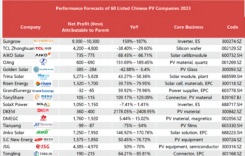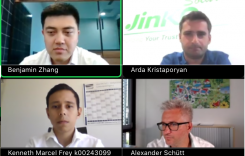-An interview with Guo Qinwen, General Manager of TBEA Xi’an Electric Design Co., Ltd.
PVTIME – Although the 2020 SNEC was held later than previous years due to the COVID-19 pandemic, the quality of the exhibition was unaffected. The focus of the annual exhibition held in Shanghai has always been on new products and technology, and TBEA New Energy certainly did not disappoint its visitors with its VR booth which provided a three-dimensional visualization of their work in digital engineering design.

However, visualization is merely only one aspect of digital engineering design. What exactly is digital engineering? Is it still just a gimmick? What impact will it have on the industry as a whole?
In order to uncover the mysterious veil and understand the low-key and practical tactic TBEA New Energy is approaching digital engineering design with, PVTIME interviewed Guo Qinwen, General Manager of TBEA New Energy’s holding company, TBEA Xi’an Electric Design Co., Ltd. to learn more.
Digital engineering design – TBEA New Energy follows the trend
Is digital engineering design a necessity or a gimmick?
Guo Qinwen believes that nowadays, both policy and technology advancements are making digital engineering design urgent and necessary.
In terms of policy, at the beginning of 2019, the National Development and Reform Commission and the National Energy Administration issued <The Notice on Actively Promoting the Work of Wind Power and Photovoltaic Power Generation Without Subsidy>, officially stimulating the progress of achieving grid parity from the policy level. With the advent of the era of grid parity, efficient and effective reduction of LCOE has become a real demand. Digital engineering design technology can fundamentally provide the best solution for attaining optimal electricity cost on the design end.
At the technical level, Guo Qinwen believes that with the development of complex mountainous region, utility-scale, and distributed rooftop projects, digital engineering design will become the developmental trend of the industry in the future. The designing of these types of new energy projects has brought opportunities for the development of digital engineering design technology. With the advent of the era of grid parity, project power generation capacity and construction cost evaluations will be carried out and become more important than ever. Therefore, it is necessary to construct a digital engineering ecosystem to better manage the whole life cycle of a project.
In terms of operation and output, digital engineering design technology not only has all the characteristics and advantages of traditional design methods but also the advantages of intelligent data processing, intelligent error correction, multidisciplinary collaborative design, high-performance interactive design, and other advantages traditional design methods do not have.
Guo Qinwen concluded that the reason why digital engineering design should be respected by everyone can be summarized in three points: efficiency improvement, cost reduction, and downstream needs.
Under such circumstances, TBEA New Energy is taking advantage of the trend and has created its own digital engineering design platform.
Open and open-source, TBEA New Energy wants to build a sharing platform
“We don’t want to be just a gimmick. We need to do things for the sake of digitization so that more people can benefit from TBEA New Energy’s Design and Engineering Platform.” Guo Qinwen said.
TBEA New Energy Design and Engineering Platform is divided into four systems: digital resource assessment system, digital engineering design and construction management system, and post-project evaluation system. The digital engineering ecosystem is built to govern nine aspects which include, project macro site selection, resource evaluation, micro site selection, economic evaluation, project design, project construction, project construction management, project O&M, and project optimization and improvement.
The digital resource assessment system provides project feasibility assessment in the project establishment, acquisition, and EPC stages. It provides solutions for project decision-making, assessing project risks, and managing project-related data.
The digital engineering design and construction management system’s main function is to improve design accuracy and efficiency through digital design during the project design phase, and reduce project costs. In the project construction phase, it applies standard digital construction models to improve project construction progress, determines rational use of construction materials, and controls the project timeline through digital simulations, so as to realize the digital management of the project.
The post-project evaluation system works in tandem with the TB-eCloud platform to account for the project’s climate and environment in order to create a digital post-evaluation platform that integrates operation and maintenance management, optimization, and improvement. The platform analyzes and predicts the operation of the project and generates suitable plans for regular inspections and overhauls based on the results. It provides systematic solutions to corresponding failures, and improves the project’s quality and efficiency through digital means.
According to reports, TBEA New Energy has completed the construction of its digital design system. So far, it has completed the design of a 110kV booster station, a wind farm in a mountainous region, a roof photovoltaic project, and is being applied to more projects. It is expected that by the end of 2020, the platform will achieve perfect digital 3D design as well as 3D result delivery capabilities in the fields of wind, solar, power transmission and transformation.
With 13GW of experience, TBEA New Energy supports the era of grid parity
Nowadays, digital engineering design has attracted the attention of many companies such as Goldwind, Envision, Mingyang Smart Energy, Shanghai Electric, etc. A digital system platform can solve many issues associated with the increasingly complex development environments, power generation systems, precise design requirements, lower electricity prices, and data and information.
Guo Qinwen believes that TBEA New Energy Design and Engineering platform’s main advantage comes from its efforts in the integration of project development, engineering construction, operation management, project O&M, key equipment manufacturing, and power system software development. Also, TBEA New Energy has accumulated rich project experience and big data thanks to its 13GW track record. The implementation of its digital platform allows companies to break the “interdepartmental wall” in one fell swoop, realize the real-time sharing of application data and information across various industrial sectors, and quickly enhance its competitiveness.
As for the future, Guo Qinwen believes that the use of digital engineering design platforms and big data analysis will provide internal and external customers with accurate data support and analysis during the pre-development phase of a project, help achieve efficient, accurate, and reliable decision-making. In the project’ construction stage, design results will be transferred to the project construction unit through intuitive and digital 3D visualizations, improve the quality of design drawings and construction efficiency, reduce unnecessary waste in the project construction process, so as to reduce the project construction cost.
For the new energy industry, Guo Qinwen predicts that as technology continues to develop, digital engineering design platforms will directly change the way project data is collected. Current manual recordings and image recordings will change to spatial measurements and 3D dynamic recordings, and the data quality and collection efficiency will both greatly improve. In addition, the intelligent data processing, intelligent error correction, multi-discipline collaborative design, and high-performance interactive design possessed by digital engineering design will directly change the traditional design method and produce a more economic and efficient design scheme.
Moreover, the digital engineering design platform will realize the digital management of the power station throughout its life cycle. Through the accurate evaluation of power generation capacity, refined project design, and reduction in construction cost, the project will ultimately achieve grid parity.
Guo Qinwen firmly believes that the development and application of digital design will actively promote China’s energy revolution and help realize economic transformation and upgrading.











